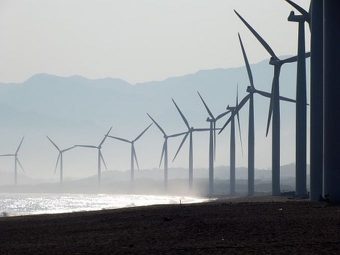
A new analysis from Aurora Energy Research which highlights “the new economics of offshore wind” has shown that offshore wind in the United Kingdom could reach up to 30 gigawatts by the 2030s.
European energy analysis firm Aurora Energy Research published a new report this month which concluded that “The volume of offshore wind” in the UK electricity mix “could be materially increased through intelligent market design and regulation.” Aurora also analyzed two policy mechanisms that would allow for greater offshore wind energy penetration — zero subsidy Contracts for Difference contracts and allowing offshore wind to ‘revenue-stack’.
Aurora believes that the UK Government must continue the Contract for Difference (CfD) scheme, which will provide “wholesale market revenue stabilisation” to the offshore wind sector. By 2025, if the CfD scheme is allowed to continue along its current trajectory, Aurora believes that offshore wind costs will have reduced such that CfD bids would effectively require zero subsidy — in other words, “bids will be costneutral and set at the level of the offshore wind ‘capture price’ in the wholesale electricity market, resulting in no net subsidy payments over the 15-year term of the CfD contract.” We’ve already seen zero subsidy offshore wind projects around the world, and it is only a matter of time before offshore wind costs decline far enough that it simply becomes the norm.
The end result of Aurora’s analysis is that, with the right policy measures providing consistent stability for the sector, offshore wind in the UK could eventually reach 30 GW (gigawatts) by the 2030s, up from the 6 GW currently in operational.
“Stabilising future market revenues via Contracts for Difference significantly reduces risks for investors and is critical in attracting financing and supporting further offshore wind build-out, albeit some future price or merchant risk is transferred to the government and ultimately consumers,” explained Hugo Batten, Senior Project Leader at Aurora and author of the report (PDF).
The second policy, allowing offshore wind to ‘revenue-stack’, would help level the playing field through regulatory adjustments which allow offshore wind access to additional revenue streams and ancillary market revenues — much in the same way of dispatchable generation or energy storage. According to Aurora, offshore wind energy has the technical capability to provide a range of balancing and ancillary services to the UK electricity grid — including the ability to rapidly ramp-up and -down electricity generation to help balance demand and supply.
Supporting the development of offshore wind energy to around 30 GW in this way would also have natural additional benefits, such as helping to reduce carbon emissions by approximately 60 g/kW by the late 2030s. It also reduces system costs by around 7% and results in annual savings of around ~£1-2 billion per year by the 2030s. It will also limit offshore wind’s system integration costs (‘cost of intermittency’) to £6-7 per MWh in the 2030s and signal a viable long-term route to market for offshore wind to provide further confidence in the offshore wind industry in GB, helping to secure further investment, jobs and supply chain opportunities.
Source: cleantechnica.com



